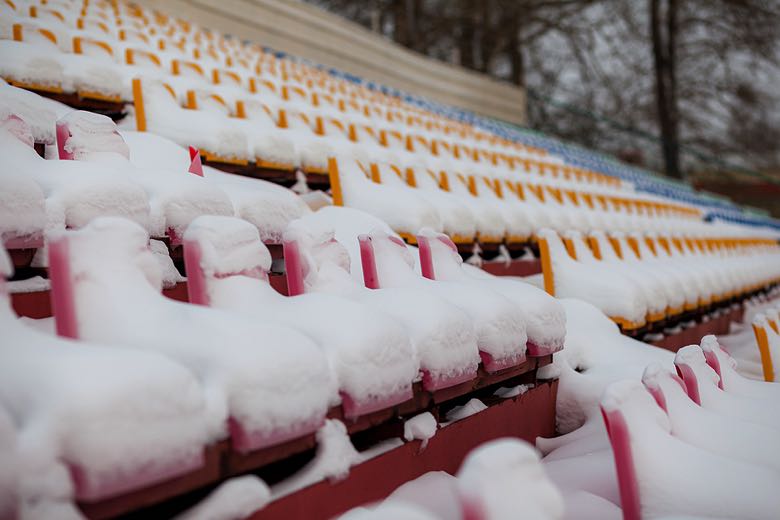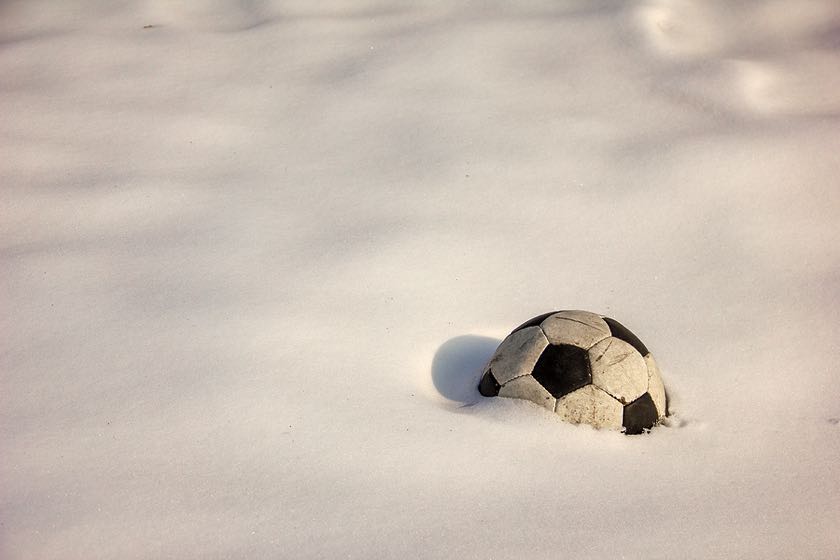Anyone that follows America’s Major Lague Soccer got a rare treat in March 2024 when Real Salt Lake took on Los Angeles FC on home soil. The game felt unique because Salt Lake’s pitch was completely covered in snow – it was alien to see the players having to adjust to the conditions, which saw the ball travelling at sluggish speeds across the ground.
the gif you’ve been waiting for pic.twitter.com/OAoJ4Y7sEZ
— Real Salt Lake (@realsaltlake) March 3, 2024
To make matters worse for LAFC, a blizzard broke out during the game – but still it went ahead as they were condemned to a 0-3 defeat. Los Angeles head coach Steven Cherundolo blasted the decision to play on as an ‘absolute disgrace’. “It was impossible conditions. I feel terrible for the players that we put them through this,” he commented afterwards.
So, why did the game go ahead? Can football be played in the snow? And, why don’t we see snow games in English football?
Why Are Football Games Postponed?

It was decided in that RSL vs LAFC game that the conditions were safe enough for the contest to go ahead. And that is one of the key considerations when determining whether a football game is postponed due to the snow: is the welfare of the players at risk?
Another factor is the welfare of supporters travelling to and from the game. Is the snow settling on the ground? How much is forecast? If travel conditions become dangerous, it’s possible that the game will be called off to ensure that thousands of people aren’t on the roads or using public transport in sub-zero temperatures.
That is one of the reasons why Premier League matches and those in other top-tier competitions can be postponed. Although the pitch is itself playable – many big clubs now have undersoil heating and covers that help to keep the snow at bay, the prevailing conditions around the game can be considered unsuitable.
In lower league football, clubs can go to great lengths to get games on – including players, staff and volunteers even shovelling snow off the playing surface. That can ensure that a match goes ahead, but only if the pitch isn’t frozen.
One of the other determining factors is the country’s preparedness for snow and cold weather. In Russia, for example, games are rarely called off in the Premier Division, despite winter temperatures regularly dropping below zero and snow being a regular foe – this is a country that is simply built to deal with Arctic conditions.
Why Do They Use a Yellow Ball in Football?
When games are able to go ahead in snowy conditions, one of the problems is being able to see the white ball against such a backdrop. There’s no problem for the players at ground level, but for the supporters watching on from the stands and the TV viewers at home, it can be almost impossible to track where the ball actually is – other than to trace the players’ movements.
The orange ball was devised to counteract the problem – with Adidas one of the first sports manufacturers to produce an orange ball, which became famously known as ‘Tango’ due to its illuminous orange colouring. That sphere was used in English football on snow days throughout the 1980s.
Today has an orange adidas tango feel about it….👌🏼 pic.twitter.com/xOrKQJZnlZ
— 80s Football (@80s_football) November 28, 2021
Other brands put out their own official orange match balls, before there was a palette change in the 2000s – Puma, and other ball manufacturers, bringing out a hi-vis yellow option that is used in the EFL when the clocks go back for winter.
Football’s Most Memorable Snow Games
There aren’t that many have high profile games that have been blighted by the snow in recent years – of course, major competitions like the World Cup are held in the summer months of the host nation to minimise the risk of adverse weather being a factor.
But that hasn’t always been the case. Arsenal’s old ground Highbury, for example, was one of the first to have undersoil heating installed – so even as far back as the 1960s they were able to get games on in the snow and ice. The problem was that, in the days before all-seater stadia, many grounds had open terracing that was exposed to the weather – so Arsenal, on more than one occasion in the sixties, would play games with their famous Clock End stand closed due to the snow.
Decades later, Highbury still had problems with the snow – so much so that ahead of one Arsenal game against Coventry City in 1987, Gunners boss George Graham promised supporters a free ticket to the game if they turned up early to help clear the pitch and surrounding areas.
One famous game at Ewood Park saw dozens of staff members and volunteers clearing the pitch of snow ahead of a clash between Blackburn Rovers and West Ham in 2010. The contest was played out on a gloriously green pitch with the snow shovelled just off the touchlines – cue Hammers striker Carlton Cole being unceremoniously dumped in a snow drift following one robust tackle. Happily, Cole took it well – even giving himself a snow shower afterwards.
Just Carlton Cole playing in the snow 8️⃣ years ago today… pic.twitter.com/ytvvCZn3QL
— West Ham United (@WestHam) December 18, 2018
A similar scenario unfolded at Leicester’s King Power Stadium in March 2018, with Wilfred Ndidi this time the unlucky soul to be crashed into the snow pile by Bournemouth’s Lewis Cook. The Nigerian responded by forming a snowball and throwing it at Cook, who picked up the remnants and threw them back at Ndidi. The pair exchanged words, before seeing the funny side.
Ndidi and Cook having a snow fight mid game 😂😂 pic.twitter.com/MidPLRBPBN
— Aura (@90k_Aura) December 22, 2023
And, of course, the infamous snow mound at the side of the pitch offers the perfect – albeit chilly – celebration:

